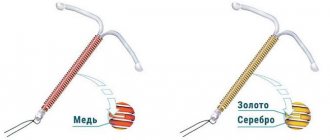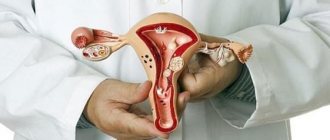After a cesarean section, the mother's uterus recovers somewhat more slowly than after a normal birth. This is due, first of all, to the fact that cesarean is still an abdominal operation, which is not natural for the body, but rather, on the contrary, traumatic. Thus, during surgery, blood vessels, muscle fibers, and nerve endings are damaged. After the procedure, the uterus has a scar, the healing of which requires some time and special care.
How long the uterus can contract after cesarean surgery depends on many factors. With a planned operation and the absence of any complications, in order for the woman’s body in general and the uterus, in particular, to reach a satisfactory state, it takes no less than 2 months, that is, almost the entire postpartum period. If the outcome is good, the reduction process occurs by itself. However, in some cases it is necessary to prescribe drugs that would stimulate this process to proceed somewhat more quickly. These drugs have a stimulating effect on contractile activity and also have a hemostatic effect on damaged vessels.
In general, the process of complete recovery of a woman’s body after a caesarean section takes about two years. Why so long, you ask? Did you know that during pregnancy, a woman’s uterus enlarges almost 500 times? So your body will have something to work on.
In the meantime, when the uterus after cesarean is still quite stretched and measures from 10 to 12 cm in diameter, when the scar is still very fresh, the woman feels a certain discomfort. It may be associated with pain in the incision area, fear and difficulty going to the toilet, coughing, turning over from side to side, etc.
All these nuances are discussed and decided with the doctor who sees the mother during the postpartum period.
As measures to help more comfortably survive the postpartum period, in addition to medications, the woman is prescribed a diet that is acceptable for both her and the baby, as well as wearing a special bandage that protects the tissue from further stretching at a time when effective physical exercise is not yet possible for the woman. not possible. At first, while the uterus has not yet contracted after the cesarean section procedure, and the suture has not healed properly, the woman should get an assistant who will relieve her of housework and heavy lifting, which can very significantly affect the quality and speed of the recovery process.
Read also:
Basic recommendations for planning pregnancy after cesarean section
How long does the uterus contract after cesarean section?
This process is unpredictable. Much depends on other factors. The female body needs several years to recover. Immediately after surgery, the girl experienced severe discomfort in the incision area. A special bandage, diet, and medications will help restore the health of the young mother. After the operation, the girl needs time to return to her previous routine, so there is no need to lift heavy objects and become overtired. The area where the placenta was located and the incision was made was the most damaged area. There may still be a blood clot and part of the fetal membrane present. A few days after a cesarean section, bloody discharge begins to appear. Every day the shade of blood becomes lighter.
How fast does everything happen?
How long does the uterus contract after cesarean section? During the period of bearing a baby, the uterus increases 500 times. Immediately after labor, the organ weighs 900 g, after 7 days 500 g, and after 8 days - 340 g. After 90 days, the organ acquires its prenatal size and weight. The uterus will contract most actively in the first few days after labor. In the future, this process will slow down. During the contraction of the organ, cramping and nagging pain occurs. Such sensations should not be a cause for concern. In some cases, this sensation causes severe discomfort and interferes with leading a normal lifestyle. In such circumstances, it is important to consult your doctor, who will prescribe pain medications. With the help of antispasmodics you can quickly eliminate unpleasant symptoms. In some situations, the uterus contracts slowly. For this reason, bleeding or other complications may occur.
What to do if the organ contracts slowly?
“How long does the uterus contract after a caesarean section?” - a question that interests many, but not everyone knows that much depends on the general health of the mother in labor and other factors. If the pregnancy was multiple, and the weight of the fetus exceeded the norm, then the contraction process may be delayed, since under such conditions the uterus can stretch more. If the placenta was located low, the contraction occurs more slowly. When labor is weak, doctors often perform an unplanned caesarean section. Under such circumstances, the organ will take much longer to recover. In addition to all this, it is important to take into account the general health of the patient and the presence of other concomitant diseases. If there is a strong inflammatory process in the body, then the uterus may not contract at all.
What if the contractile activity is too long?
What can affect the timing of uterine contractions after a caesarean section? First of all, it is worth mentioning about multiple pregnancies or large fetal weight. At the same time, the uterus stretches more and, accordingly, the mother’s body requires more strength and time for it to contract.
The contraction process can also be slowed down if the placenta was low, if the caesarean section was not planned, but was due to weak labor, and also if the woman after childbirth leads a very passive lifestyle and moves too little. Among other things, one cannot discount the woman’s general health, her readiness for cesarean section, concomitant diseases (hyper- or hypotension, nephropathy, etc.).
Read also:
What do you need to know about the features of the recovery period after cesarean section?
Speaking about how long the uterus can contract after a cesarean section, one cannot help but draw your attention to inflammatory processes, physiological developmental features (such as bending or underdevelopment of the uterus), which, by the way, may cause the uterus not to contract at all. This is also possible in the case of an injured birth canal, the presence of fibrous formations in the walls of the uterus, inflammation of the appendages present or even in the past, with a blood clotting disorder or polyhydramnios that accompanied pregnancy. Then the time required for uterine contraction can only be affected by timely and correctly prescribed treatment.
The doctor must determine how normally the process of uterine contraction is proceeding before discharge.
If he deems it necessary, the mother will be prescribed drugs that stimulate contractility - oxytocin or prostaglandins.
Sometimes a massage of the fundus of the uterus is also prescribed, which is performed through the anterior wall of the peritoneum.
Is it possible to speed up this process?
To stimulate contraction of the organ, it is necessary to breastfeed the baby. During feeding, the substance oxytocin is released. Thanks to this, the uterus contracts faster. In some situations, after childbirth, doctors do not recommend breastfeeding the baby, since the young mother takes antibiotics to prevent post-operative infections. How long does the uterus contract after a caesarean section? The process is quite individual. Thanks to physical activity, you can reduce the time of uterine contractions. Doctors often recommend that women lie on their stomachs because this helps the organ contract faster. It is equally important to regularly treat seams and carry out hygiene procedures to prevent the introduction of harmful microorganisms. It is important to empty your bladder in a timely manner and avoid constipation. If you experience severe pain in the abdominal area, you should immediately consult a doctor, as serious complications may occur.
What else causes the uterus to contract?
An excellent stimulator of contraction is breastfeeding, during which oxytocin is also released. That is why, in order for the uterus to contract more actively, women who have given birth (here - caesareans) are recommended to start breastfeeding their babies as often as possible. In some maternity hospitals, mothers are allowed to rest in the first days, and antibiotics are also prescribed to prevent postoperative infection, and for these reasons, babies are bottle-fed for the first days. Therefore, being aware of these issues, you can discuss such nuances with your obstetrician-gynecologist in advance.
An active lifestyle, in this case – regular walks in the fresh air – walking.
Such physical activity not only helps to reduce the time of uterine contraction, but is also a preventive measure for starting the adhesive process after surgery.
In addition, in order for the uterus to contract better after childbirth by cesarean section, women are advised to lie on their stomachs more often, ideally (if their breasts allow) to sleep on it.
It is also worth taking hygiene procedures very seriously, treating the seam in a timely and correct manner, preventing the penetration and spread of infections.
Read also:
When does milk come in after a caesarean section?
An important factor influencing the normal contraction of the uterine body after a cesarean section is the timely emptying of the bladder and bowel movements. Often these processes, which are completely natural for a healthy body, give the woman who gave birth (whether independently or by cesarean section) a lot of unpleasant sensations. However, these nuances are extremely important not only for the normal contraction of the uterus, but also for the functioning of other systems and organs, and the recovery of the body after surgery in general. Unfortunately, many women are embarrassed by such problems and delay contacting a doctor. This should under no circumstances be done in order to avoid problems in the future and ensure a good quality of life for yourself and your baby. After all, healthy children most often grow up with healthy mothers.
What to do if the organ does not contract?
How long does the uterus contract after a caesarean section? It all depends on many factors: the general health of the patient, whether the operation was planned, etc. In some cases, the uterus does not contract at all. In frequent cases, this occurs due to the fact that lochia remains, which should come out naturally. If blood clots remain in the uterus, complications may occur. A woman in labor often experiences a rise in body temperature and severe weakness. In this case, it is necessary to carry out cleaning, so-called scraping. Under such circumstances, the doctor will remove blood clots and residues mechanically. If this is not done, severe inflammation may occur, which will lead to endometritis or sepsis. It is not enough to know how many days the uterus contracts after a cesarean section, since this process is individual.
Deviations from the norm and possible illnesses
The course of a woman’s postpartum period follows a schedule in which only minor deviations are permissible (no more than 10-12 days, up or down). A significant impairment of recovery may indicate the development of diseases, namely:
- Lochiometer. Discharge stops in 1-2 weeks due to impaired contractility of the female reproductive organ. There is pain in the lower abdomen. The uterus is not completely cleansed, inflammation develops.
- Parametritis. The volume of postpartum discharge increases sharply, admixtures of pus and voluminous blood clots appear. The condition worsens quickly, fever, weakness occur, and symptoms of intoxication increase.
- Vaginal candidiasis. The discharge becomes lighter, the woman complains of itching of the genitals and painful urination. Treatment is difficult due to decreased immunity.
- Endometritis. Lochia is purulent, abundant, and has a sharp putrid odor. The woman's temperature rises and symptoms of intoxication appear.
The listed conditions are dangerous for a woman and threaten her life, therefore, if the slightest doubt arises, you should consult a gynecologist. After the initial examination, the doctor will make a preliminary diagnosis, which must be confirmed by ultrasound.
To summarize, it must be said that postpartum lochia is an important marker reflecting the process of endometrial regeneration after pregnancy and childbirth. There are no strict norms for the course of this process, but the duration and abundance of discharge is approximately the same for all women. Significant deviations are a reason to consult a doctor; delay in diagnosis is dangerous for the life of a woman in labor.
This article is posted for educational purposes only and does not constitute scientific material or professional medical advice. Always trust your doctor first!
How to identify danger?
Many people are interested in how much the uterus contracts after a second cesarean section? But not everyone knows that this process is unpredictable, since it is influenced by many factors. In the maternity hospital, nursing staff look after postpartum women every day. After being discharged home, you need to listen to your body. It is important to pay attention to any unpleasant symptoms that cause discomfort, as they can cause serious complications. You should definitely visit a doctor if:
- several months after a cesarean section, uterine discharge continues to appear;
- 7 days after the operation, the discharge is just as heavy;
- The body temperature rose significantly and my health worsened.
If bleeding occurs, you should go to the hospital immediately. The remainder of foreign tissue in the uterus often provokes the development of complications. Hypotension may occur. Under such conditions, the organ does not contract. It is forbidden to solve the problem at home, as this can be fatal.
Many people know how long it takes for the uterus to contract after a cesarean section on average. If the process is too painful, you can take a medication prescribed by your doctor. “No-spa”, “Ibuprofen”, “Ketoprofen”, “Lidocaine”, “Naproxen” will help eliminate unpleasant and painful sensations. You should know that it is not recommended to take medications systematically, since it is necessary to eliminate the cause that provokes intolerable pain. Self-medication can be harmful and lead to complications.
Why does uterine contraction after cesarean section not occur as quickly as we would like?
After a caesarean section, the uterus recovers slowly. There are 7 reasons for this.
- The first reason is a scar on the uterus. Vessels and nerves are damaged. The nutrition of the organ is disrupted. The body must spend energy not only on restoring the uterus, but also on healing the scar.
- The second is that blood loss during cesarean section is much greater than that during childbirth. With low hemoglobin, hypoxia occurs - oxygen starvation of organs and tissues, which negatively affects the recovery of the body after childbirth; the uterus will take a long time to recover.
- The third reason is physical inactivity. After a cesarean section, the woman is forced to remain in bed for the first 24 hours. In the following days, her movements are limited due to pain.
- The fourth reason is that it is necessary to carefully monitor bowel and bladder emptying. If by the third day after cesarean there is no stool, you need to do an enema. A full bladder and rectum prevent the uterus from returning to normal.
- The fifth reason is an overstretched uterus: if there was polyhydramnios, a large fetus, twins or triplets, if it was not the first birth, but the 3rd and subsequent ones.
- The sixth reason is if a cesarean section was performed due to the weakness of labor. The uterus is not sensitive enough to hormones that promote its restoration.
- The seventh reason is that the uterus is bent anteriorly, which can interfere with the outflow of lochia.
Therefore, it is important to monitor how the uterus is recovering and take action at the first signs of disruption.
First aid
If in the first few days after childbirth a woman does not experience bloody discharge, and there is no pain or cramping sensations, this is a cause for concern. In this case, it is necessary to prescribe treatment that will help activate the process of uterine contraction. Using the artificial hormone oxytocin, you can speed up the process of organ contraction and prevent severe bleeding. Many people are concerned about how many days does the uterus contract after a cesarean section? The most active contraction occurs in the first days after birth; if this is not observed, it is necessary to install an IV.
If a woman feels unwell and has no strength after childbirth, then doctors prescribe an Oxytocin drip. Treatment is carried out using “Gifotocin”, “Demoxytocin”, “Dinoprostone”, “Ergometrine”. The medicine is prescribed to the patient both in the form of tablets and injections. Any of these medications is prescribed by specialists if the uterus contracts poorly. Some doctors are of the opinion that it is not recommended to inject Oxytocin after childbirth, since this process (cleansing the uterus and contractions) should start on its own. In some situations, gynecologists prescribe folk remedies.
Normal color and volume of lochia during CS
If there are no complications in the postoperative period, in the first 7 days there is abundant red lochia with voluminous clots. The remaining particles of the placenta and amniotic sac are gradually removed from the uterine cavity, residual rejection occurs and the discharge changes in abundance and becomes thick. This condition lasts from 45 to 60 days and often lengthens if the mother refuses breastfeeding.
3-4 weeks after cesarean section, the discharge becomes lighter, less abundant, and may look like ichor. At 6-8 weeks, a clear discharge is observed from the woman’s genital tract.
Weekly characteristics will help women distinguish normal from pathology:
- At 1-2 weeks they are abundant, with clots of bright scarlet color.
- At the beginning of the 3rd week - mucous-bloody, similar in consistency and abundance to normal menstrual bleeding. They have a red-brown color.
- From 4 weeks and later, bloody, sparse, yellow or dark brown.
Postpartum discharge should not cause discomfort in the form of itching, burning, pain or unpleasant odor. The volume of discharge and color should change gradually.
Attention! For normal uterine contractions after CS surgery, medication is required. The woman is prescribed intramuscular injections of oxytocin.
At different points during the recovery period, the discharge changes its color:
- In the first 7 days they are red. The volume of discharge in the first 5 hours is about 400 ml. At this time, the woman after the CS is under the control of a doctor, in intensive care. After 8 hours, the late postpartum period begins, lochia is abundant, has a bright color and a musty smell. On day 5, their volume decreases noticeably, but the discharge remains abundant for 2 weeks.
- Serous lochia begins 14-18 days from the date of birth, the discharge changes color from bright red to brown. The volume is halved, the pungent odor is eliminated. Starting from the 30th day after the CS, they lighten and become yellow.
- Light. They become spotty, have a light brown color, then become invisible, transparent with a white or yellow tint.
Only scarlet, red, dark red postpartum discharge can be abundant. If the lochia is yellow or green and comes out profusely, you need to urgently consult a gynecologist; the woman probably has inflammation of the uterus.
List of folk remedies
How long after a cesarean section does the uterus contract, and how to speed up this process using folk methods? Before using any folk remedy, you should consult a doctor, since treatment at home can be very harmful and cause serious complications. You should know that the uterus contracts within two months, but this is an approximate period. Using nettle, you can improve the general condition of a woman after childbirth. To prepare a healing remedy, you need to pour boiling water over the plant and leave to infuse for an hour. Drink 90 ml throughout the day. Leaves of white damselfly must be filled with warm water in a proportion of 3 tbsp. spoons per 600 ml of water. The product should be infused for one day. Before use, strain and take several times a day.
Massage treatment
With the help of massage you can speed up the process of uterine contractions. In the first days after labor, a doctor comes to the woman’s room and performs a therapeutic massage, during which incredibly severe pain occurs, while the procedure is useful and speeds up the woman’s recovery process. To make the organ shrink faster, homeopathy is used. The main advantage of this treatment is that the preparations do not contain synthetic and chemical elements. With the help of “Splint”, “Millefolium”, “Paradise”, “Sabina” you can speed up the healing of the uterus and eliminate heavy bleeding.
Physiotherapy
Many people are concerned about how long it takes for the uterus to contract after a cesarean section, but not everyone knows that with the help of special exercises you can speed up the process of uterine contraction. A useful physical exercise will not require a lot of effort and time from a woman. Timely completion of a set of exercises will help speed up the recovery process of a woman’s body.
- Lying on your back, you need to straighten your legs and connect them. Then we bend and unbend them at a slow pace. Perform 5-7 approaches.
- We squeeze and relax our toes.
- We lie on our backs, relax, straighten our legs and pull our toes towards us.
- Sit on a gymnastic ball and perform a circular movement in different directions.
It is important to consult a doctor before starting exercise, as self-medication may make the problem worse.











